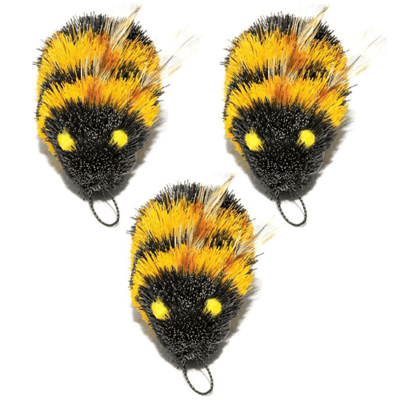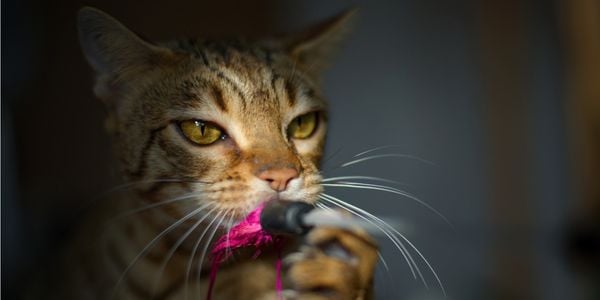
Cats are predators! They're designed to hunt.
It's not just about food. It's instinct — an inherent need.
So, what happens when our cats aren't able to hunt? Maybe the better question is, what incredible things happen when we give our cats the opportunity to hunt through play? This is something every cat parent should know. But not many do.
It's a simple play technique that can change everything for you and your cat. Want to know why? I explain it below.
How to Play With Your Cat Using the Prey Sequence
You've seen it in countless wildlife documentaries. When cats hunt, they follow a precise sequence. It's this sequence that you're going to recreate for your cat using play. I explain why it's so important and how best to do it in more detail further below. But first, let's dive right into the four steps of the prey sequence:
Staring: Your cat crouches down low. Their eyes get really big as they lock onto their target.
Stalking and chasing: You may see your cat start to move very slowly and carefully to get into position. Then, at just the right moment, they take off after their prey.
Pouncing and grabbing: When they get to their prey, they pounce and grab on.
Kill bite: Then it's time for the finishing move. Your cat will take the prey in their mouth and give it a strong shake or wrap their front legs around it and bunny kick with the back legs. While this is really cute when done in your living room on a silly stuffed toy shaped like a taco — in the great outdoors, they're actually meant to break the prey's neck and disembowel it. You'll never look at that taco the same way again.
See my cat Ollie go through the four steps of the prey sequence while we're playing.
But it's not as simple as 1, 2, 3, 4. Let's face it. Cats can be rough on their prey. They don't go for quick and painless. In fact, they'll go back and forth along the prey sequence for a while. You've probably seen this in action when your cat catches a bug. They stare for a while. Then they pounce on it and do some damage. Then … they sit back and watch it flop around. After a minute, they'll jump back in and do more damage. They may even bop it a few times if it stops moving to try and get it moving again. They'll get a few kill bites mixed in as well before they deal the final blow. It's not pretty. But it's cat nature, and we take the good with the super gross.
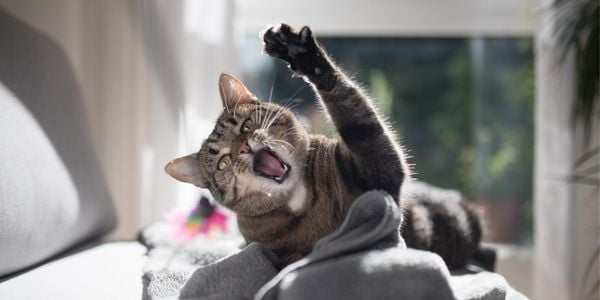
Prey Sequence Play Session for Your Cat
I can't stress enough how important this is and what a huge difference it can make in your cat's life. Pick a behavior issue. Odds are prey sequence play can help.
For play aggressive cats who may play too rough with people or pets, it provides an appropriate outlet for that natural prey drive.
For cats with seemingly endless energy, it again provides an appropriate outlet to burn off that energy in a very effective way.
For fearful or anxious cats, it wakes up their predator side and builds confidence.
For cats who don't sleep overnight, this play session right before bed can help.
For all cats, it greatly reduces stress across the board. That's why prey sequence play is part of every behavior plan I create, and I share it with every client, shelter, veterinary clinic, and sometimes even random strangers.
Choose the Right Toy
For prey sequence play, you've got to use a wand toy. Think back to the steps in the sequence. Not all toys can take your cat through each one of those. But a wand toy can do it with you at the helm.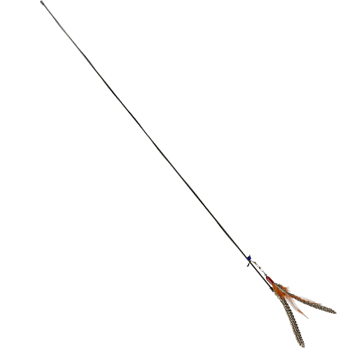
The type of wand toy also matters. Avoid small wands with short strings or wires and only one option for the lure at the end. Those are fine for other play. But they're not quite right for this play.
You want a wand toy with a long, thin string and a clasp on the end so you can swap out the lures. My hands-down all-time favorite is Da Bird.
Trust me when I tell you this wand toy moves in a way others don't. I have client after client say that their cat isn't playful. But when we get out Da Bird, that changes.
One word of caution. You MUST put Da Bird (and lures) away when you’re not actively playing with your cat. There are many chewing and choking hazards here. Don’t risk it. Your cat will eat the string.
Choose the Right Lure
You can use any lure with this wand. But Da Bird also has some unique lure options that are great for cats who may not be super playful. Their standard feather lure spins as it moves and makes a slight sound in the wind that can appeal to cats. And their rat lure, unironically called "Da Rat," is made from deer fur. As a vegan and animal lover, I hate this idea. But as a cat lover who respects my cat's predatory nature, I begrudgingly accept it. That's because real fur or hide can often be the trick to getting an unresponsive cat playing.
When it comes to lure selection, remember two things:
Cats get BORED very quickly. That's why it's important to have a wand with a clasp so you can change the lures often.Cats have preferences. Not all cats love to hunt birds. In fact, cats will also hunt insects, rodents, snakes, and lizards. Your cat may act like a bird lure doesn't exist. But you put a moth or bumble bee lure on the end of that wand, and look out!
Each type of "prey" moves differently, so have a variety of lures handy. Switch them out often. And if your cat seems uninterested in one type, don't give up. Try another option.
Bee lure, it's a great bug option
Fish lure (not necessarily a prey type, but your cat may like it)
There are many Go Cat (Da Bird) lure options, so try a few to see what your cat loves.
We also have more cat toy options and how to use them. Some toys your cat can play with by themselves.
Stick to the Rules
There's only one rule in the prey sequence play club. Each cat should get their own play session at least once a day. They can have a shared session, too, if they enjoy it. But they need one shot a day where no one else can come in and take over or make them too nervous to play.
If you have two or more cats, give the other cat a food puzzle to work on in the bedroom or turn on a battery-powered toy while you have a play session with your other cat. Then you can swap 'em.
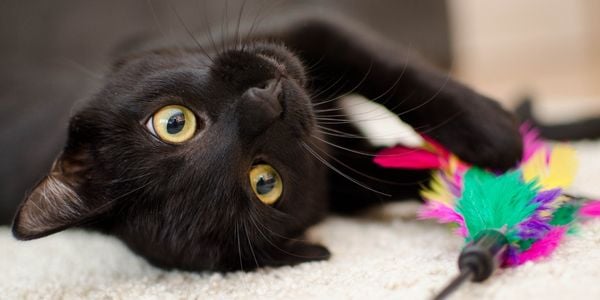
It's Time to Play Using the Prey Sequence
Now for the good stuff. You get to act like a bird, mouse, bug, or snake for about 15 minutes.
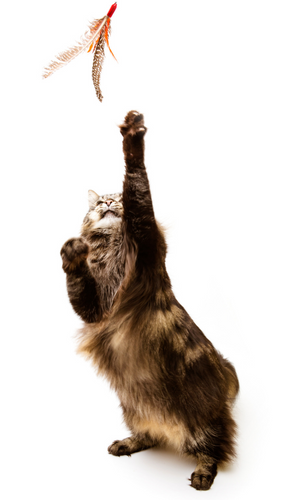
Prey Sequence Play: Quick Tips
- Play 10–20 minutes a day, 1–3 times a day, depending on your cat's energy level and desire.
- Behave like the prey, wiggle, fly, and hide behind pillows. Perhaps you start vigorously, but the "prey" will get tired, so slow down.
- Let your cat stare, stalk, catch, and bite the prey.
- Conclude play with the prey slowing down and "dying."
Let's dive into the detail:
1. Each session should be 10 to 20 minutes long, depending on your cat's interest and energy level. A cat who hasn't been playful in years or doesn't have great mobility may only be up for a few minutes of light play. That's good too.2. One session a day is your goal. Twice a day is even better. Cats who have tons of energy could benefit from 3 sessions a day.
3. Think about what these little prey critters do. Some fly. Others scurry on the ground. They might climb the walls or run behind or inside things and make a little noise. This is what's going to grab and hold your cat's attention. Use different styles of play and think as the prey would think.
4. At first, your prey might be very active, soaring around the room. On the other hand, stick with less active play movements if you have a shy or nervous cat. They might prefer prey that hides behind the pillow and makes little wiggly noises so they can sneak up on it and pounce.
5. Remember, the first step in the sequence is staring. Your cat may not attack for a while. But if they're watching, they're engaged. So, keep that lure moving! And for cats with limited mobility or those who haven't played in ages, this is great enrichment. Even if they never attack, they're actively watching, and that's a win.
6. As you get deeper into your play session, switch things up. The prey is getting tired. It's probably been beaten up a bit by your cat. Maybe now it flops around a little more or plays dead and then suddenly wakes up and takes off. Maybe this is when it starts hiding. It's that change that will keep your cat interested.
7. As you're ready to wind the session down, as unsettling as it may seem, you want to make the "prey" appear to be dying. It's not about the drama. It's about giving your cat a natural conclusion to their hunt. If they're flying around the room like maniacs chasing the bird, then you put it in the closet and leave the room; your cats are like, "WHAT THE HECK JUST HAPPENED?" That's stressful. Instead, they should feel like they're completing the hunt and the prey is nearing its end. If your cat does a big kill bite/bunny kick, that's a great time to stop. But they may not, and that's fine. Just slow things down.
Don't forget cats go back and forth along the prey sequence. Just because your cat stops chasing and goes back to watching the wand toy doesn't mean they're done. They're just "resetting" back to the staring phase. Keep moving, and they're likely to jump back in.
8. Now, they need to eat their prey. You will substitute the wand toy lure for a bite or two of wet food or a really meaty (not crunchy) treat. Meaty treats will best simulate the prey.
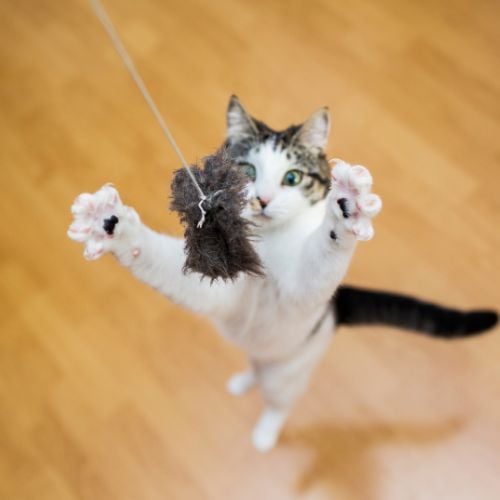
Your can has now stalked, hunted, "killed," and eaten their prey. Next is a little grooming and then a nap. You have a satisfied cat!
Play for Senior Cats
If you have an older cat who isn't playful or a cat with limited mobility, start by just letting them watch you move the wand toy around. As long as they're paying attention, they're in that first step of the prey sequence — staring. Slide it along the ground past them every now and then so they have the option to give it a swat. Even if that's as active as they get, it's still more than nothing. It's engagement. We'll take it!
Play Rule Exceptions
Of course, there are exceptions to every rule. Some cats prefer to play really hard for a minute or two, then break, then play hard, then break. You can do that with prey sequence play as well. Just be sure to wind down at the end and follow with a snack.
You may find your cat so excited by this play that they grab the lure and run off with it. That’s not a bad thing. They’re treating it like prey, which is what we want. Just follow along. Don’t leave them unattended with the wand toy. After a minute or two, they may start smacking the lure, trying to get it moving again. That’s your cue! If they’re not giving that lure up (some may even growl with excitement over their conquest), try swapping them for another toy, or have a second wand toy you can start flying around. Even if they carry their “kill” off into the other room, you want to keep the play session going.
We’d love to hear about your experiences with prey sequence play sessions in the comments. I’m not exaggerating when I tell you I’ve seen this alone make a huge difference in cats who are aggressive toward people, overly anxious cats, and cats who don’t get along with each other. Give it a shot! Have some prey sequence fun with your cat today … and every day.
Why You Need to Let Your Cat Hunt Through Play
A cat in the wild will hunt down a prey item and kill it. But if another prey item catches their attention before they eat it, they'll go after the new prey and abandon the first. It's not only about survival. Cats are instinctively driven to stare, stalk/chase, pounce/grab, and kill bite.
Think how stressed some of us would be if we couldn't have that glass of wine with dinner or spend time in our gardens on the weekends. And these are just things we enjoy. Imagine how it would feel if we were denied something our very nature and thousands of years of evolution programmed us to need.
Remember, when it comes to "domesticating" cats, we haven't really done much to change them. We never bred out all those independent, self-sufficient characteristics like hunting. The only thing we actually breed for, with cats, is appearance. They still have those same instinctual needs. The trouble comes when we don't give them ways to meet those needs that also work for us. That's where prey sequence play comes in.


